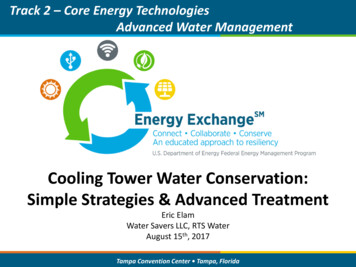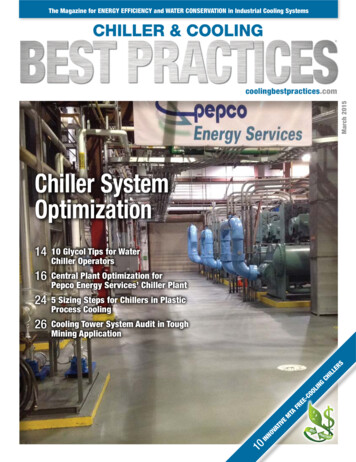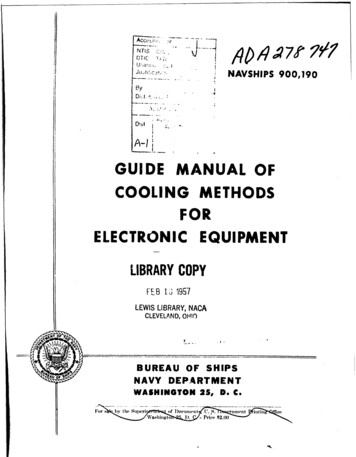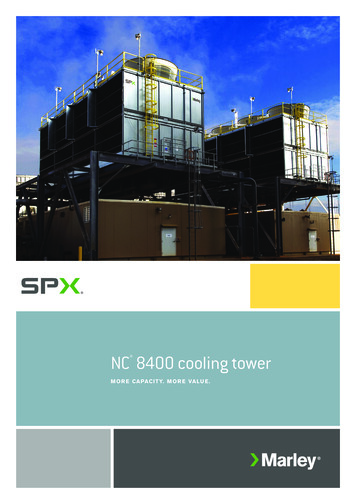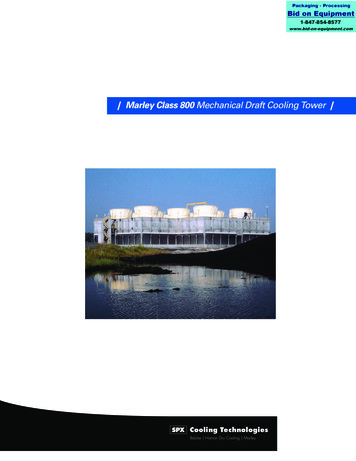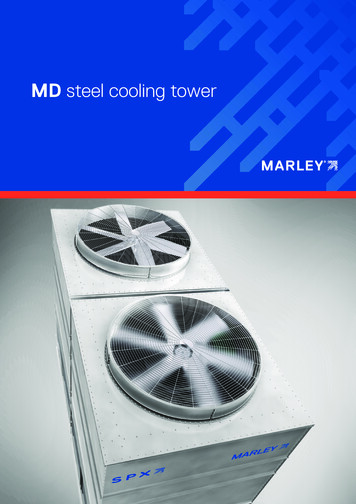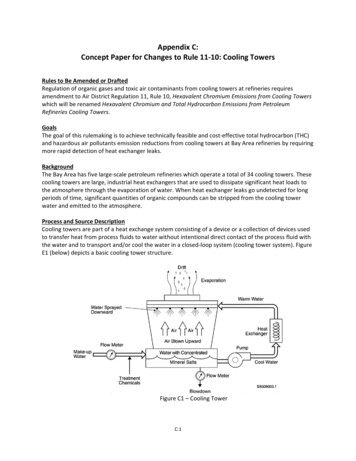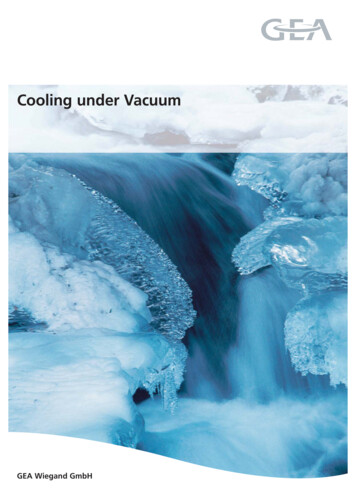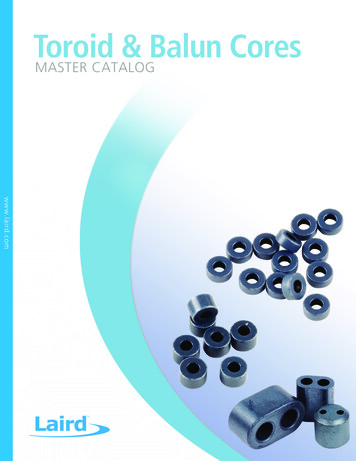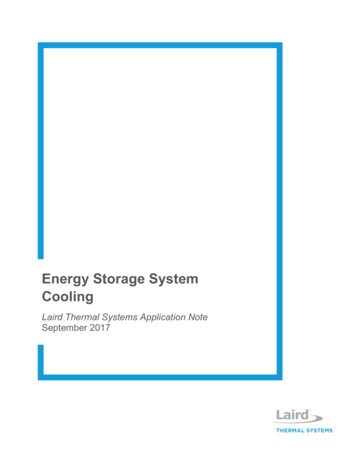
Transcription
Energy Storage SystemCoolingLaird Thermal Systems Application NoteSeptember 2017
ContentsBackground . 2Application Overview . 3Challenges . 4Compressor-based Air Conditioner Overview . 5Thermoelectric Overview . 5Solution . 8Thermal Control . 8Conclusion . 9About Laird Thermal Systems . 10Contact Laird Thermal Systems . 10BackgroundEnergy storage systems (ESS) have the power to impart flexibility to the electric grid and offer a back-uppower source. Energy storage systems are vital when municipalities experience blackouts, states-ofemergency, and infrastructure failures that lead to power outages. ESS technology is having a significant2
impact on a wide range of markets, including data centers that utilize uninterrupted power supplies (UPS)and telecom base stations that utilize battery back-up systems. Telecom base stations require energystorage systems to ensure that cloud data and communication systems stay online during a crisis like anatural disaster. A power outage that restricts or interrupts access to data and communications can causesignificant challenges for first responders and others called into action to support citizens and restoreessential infrastructure.Battery back-up systems must be efficiently and effectively cooled to ensure proper operation. Heat candegrade the performance, safety and operating life of battery back-up systems. Traditionally, batteryback-up systems used custom compressor-based air conditioners. However, thermoelectrics arebecoming more popular because they offer a lower cost of ownership option compared to other coolingtechniques. Thermoelectric cooler assemblies not only eliminate the need for a custom solution to reducethe product development time, but also to simplify installation. Thermoelectric cooler assemblies offerimproved thermal control relative to compressor-based air conditioners, maintaining temperature to within0.5 C of the set point temperature. They provide thermal control in environments where the ambienttemperature may be either above or below the battery temperature limits, simply by reversing thedirection of the current flow. Thermoelectric cooler assemblies optimize temperature stabilization toensure sensitive battery back-up systems operate at maximum efficiency — all in a smaller packagecompared to other cooling systems.Battery back-up system used for the Telecom Industry.Application OverviewA battery back-up system consists of a series of power inverters, charge controllers/rectifier, and storagebatteries. According to FCC order 07-177, when the power to a cellular antenna tower goes out,emergency batteries must provide back-up power for at least 8 hours. Many base stations are located inremote places with harsh environments, including cold mountainous areas or open desert areas with hightemperatures and high winds. These base stations can see temperature extremes ranging from very coldto very hot. Long life battery operation is required to minimize replacement as many of these systems arenot easy to access.Batteries used in cellular base stations are typically located in cabinets that are vented to protect the vitalequipment from the fumes and corrosive chemicals found in the wet cell batteries, which are often lead–acid or valve regulated lead-acid (VRLA). Several lead acid batteries are wired together in a series circuit,forming a group providing DC electric power. The more batteries that are wired together, the greater theamount of heat generated within the cabinet. Usually, there are two or more groups of series-connectedbatteries. These groups of batteries are connected in a parallel circuit, allowing one battery group to betaken offline for repair or replacement without removing the availability of back-up power. Typically, the3
larger the battery cabinet’s electrical capacity, the larger the size of each individual battery and the higherthe room's DC voltage.Depending on the location of the base station, temperatures may range from a high of 50 C to a low of 30 C. The heat generated within the battery cabinet can vary depending on the ambient temperature. Forreliable operation and maximum useful battery life, the enclosure must be maintained between 10 C to 30 C.Batteries used in cellular base stations are usually placed in cabinets to protect the equipment.ChallengesNo battery lasts forever. Back-up batteries usually show a slow degradation of capacity until they reacharound 80-85 percent of their initial rating. This is followed by a more rapid failure rate.The rated capacity of a battery is based on an ambient temperature of 25 C (77 F). Any disparity fromthis operating temperature can significantly alter the performance of the battery and shorten its expectedlife. To help determine battery life in relation to temperature, one can assume that for every 8.3 C (15 F)average annual temperature above 25 C (77 F), the life of a sealed lead acid battery is reduced by 50%.This means that a VRLA battery specified to last for 10 years at 25 C (77 F) would only last 5 years ifcontinuously exposed to 33 C (92 F) and 30 months if kept at a constant desert temperature of 41 C(106 F). Once the battery is damaged by heat, the capacity cannot be restored.In battery back-up systems, heat and overcharging are two of the most important factors that lead tobattery degradation, lower performance and even thermal runaway. Controlling and stabilizing theambient temperature seen by the back-up battery is critical to battery performance and lifetime. Batterycharging voltages need to be adjusted based on the battery temperature.This adjustment in charging voltage is known as temperature compensation, and is a feature that helpsensure that a battery is neither undercharged nor overcharged regardless of battery temperature. Allchemical reactions are affected by temperature. Battery charging is an electrochemical reaction, so it toois affected by temperature. Specifically, cold batteries require a higher charge voltage in order to pushcurrent into the battery plates and electrolyte, and warmer batteries require a lower charge voltage toeliminate potential damage to VRLA cells and reduce unnecessary gassing if flooded cells are used.There are steps to take to maximize battery life and performance, including using advanced coolingsystems. However, too many base station cabinets utilize expensive and bulky compressor-based airconditioners rather than alternatives such as thermoelectric cooler assemblies.4
Compressor-based Air Conditioner OverviewA conventional compressor-based system contains three fundamental parts: 1) the evaporator, 2) thecompressor, and 3) the condenser. The evaporator (cold section) is where the pressurized refrigerantpasses through the expansion valve and expands, boils, and evaporates. During this change of statefrom liquid to gas, energy (heat) is absorbed. The compressor acts as the refrigerant pump andrecompresses the gas into a liquid. The condenser expels both the heat absorbed at the evaporator andthe heat produced during compression into the ambient environment.Conventional compressor-based air conditioners are typically AC powered. However, if the AC powergoes out, the cooling system would shut down and there would be no cooling provided to maintain theambient temperature for the back-up battery system. In the event of a brown-out, where the availableelectrical power is reduced, the batteries may or may not be cooled appropriately. A cooling system thatoperates on a DC power supply such as a thermoelectric cooler would not be susceptible to black-outs orbrown-outs, allowing the ambient temperature of the battery back-up system to be kept constant.Many battery back-up applications experience environmental conditions that fluctuate throughout the dayand over the course of a season. Compressor systems are either entirely “on” or “off”. There is noproportional control, so full power must be applied at all times. Furthermore, the start-up current for acompressor-based system is often three times the steady state operating current, and the circuit must besized to handle the current. Combining the non-proportionality, repeated on-off control and high-powerdraw at start-up reduces the efficiency gains at steady-state that compressor-based systems offer relativeto other options such as thermoelectric systems.The compressor-based system relies on moving parts and coolants for operation. Both the compressorand motor are required to move the working fluid through the system, while fans are used to circulate theair through the evaporator. A compressor system’s components will wear out over time due to friction,thermal expansion, and on-off control. There is potential for leakage of the coolant through seals thatfatigue from continuous operation. Because of the coolant, a compressor-based system must be kept in aspecific orientation during shipping, handling and installation to prevent damage to the system. It can onlybe mounted in certain orientations, so special units are needed for different installations.Additionally, compressors are larger and heavier than other options. Compressor-based systemsexperience vibration that can have a cumulative effect on loosening hardware connections in the coolingunit and electronics in the enclosure. Noise is also a concern due to the various moving parts in thesesystems. Solid-state systems do not have these issues.Compressor-based systems are typically designed for operation between 20 C and 55 C. This range isuseful for most enclosure applications and operating environments. However, if heating is required, aseparate heater and switching circuit must be used or if higher or lower temperatures are desired, aspecial compressor for that range (with the associated refrigerant and all hardware) must be designed.All the challenges and issues with respect to compressor-based cooling systems - power, efficiency,reliability, handling and installation, vibration and noise, separate heating and cooling, and temperaturecontrol - can be addressed through the use of solid-state devices using thermoelectric cooling.Thermoelectric OverviewThermoelectric coolers are solid-state heat pump devices that operate using the Peltier effect. When anelectric current is applied to a circuit containing two dissimilar materials, heat is absorbed at one junction(the cold side) and released at the other junction (the hot side). The design of Peltier devices requires theuse of both an n-type and a p-type semiconductor. Since heat naturally flows down a temperaturegradient from hot to cold, a thermoelectric cooler’s ability to move heat from cold to hot in a solid-statestructure is unique. Also, by reversing the polarity of the applied DC current, heating is possible. This5
feature is especially useful for applications requiring both heating and cooling for precise temperaturecontrol.Thermoelectric coolers provide an excellent alternative to compressor-based cooling systems, although alack of experience with such devices may cause hesitation in some end users. Thermoelectric-basedsystems are compact, robust and completely solid state, with no moving parts, fluids or gasses. The basiclaws of thermodynamics apply to these devices just as they do to more conventional systems that provideheat transfer.Thermoelectric Cooler Assembly Technology EvaluationThermoelectric cooler assemblies, which mate heat transfer mechanisms to thermoelectric coolers, arecompact, efficient units that can control the temperature of base stations. Thermoelectric coolers serve acooling capacity spectrum from approximately 10 to 400 Watts, and can cool by removing heat fromcontrol sources through convection, conduction, or liquid means.Thermoelectric devices operate using DC power, leaving them less vulnerable to the black-outs andbrown-outs that can impact other types of cooling systems. Using DC power allows thermoelectric coolerassemblies to remove heat at a rate proportional to the power applied, so when cooling needs are low,less energy is used to maintain temperature control. This compares favorably relative to the “on”/“off”operation of compressor-based systems.Also, the ability to provide both cooling and heating with the same thermoelectric device, simply byreversing the direction of the current flow, means that the rapid cycling from thermal overshootingbetween competing cooling and heating devices can be avoided. Thermoelectric cooler assemblies offera high degree of thermal control, increased energy efficiency, and improved reliability over other coolingsystems.Thermoelectric cooler assemblies offer several additional advantages over other cooling technologies.For example, conventional fan trays do not cool to below ambient and require an air exchange with theoutside environment. Thermoelectric cooler assemblies can cool to well below ambient and protectelectronics inside enclosures from outside contaminants, and prevent exposure from the outsideenvironment. Thermoelectric cooler assemblies also provide precise temperature control with accuraciesup to 0.01 C of the set point temperature, due to their proportional type control system.The operating range for a typical thermoelectric cooler is -40 C to 65 C for most systems. Forcompressor-based systems, the typical operating range is 20 C to 55 C, allowing thermoelectriccoolers to operate in a much larger environmental area.Thermoelectric cooler assemblies feature a solid-state construction, so they do not have compressors ormotors. Therefore, they offer a more compact form factor and lower weight than conventionalcompressor-based systems. The only moving parts in thermoelectric cooler assemblies are fans on thehot and cold sides, which circulate the air after heat is absorbed in the cabinet and dissipated to theenvironment. This means that they have much lower noise and vibration and a longer life cycle comparedto competing technologies.Thermoelectric cooler assemblies do not use any type of coolant, meaning that they are mountable inmultiple orientations without any impact to performance or reliability. Since no CFCs are used, they areenvironmentally friendly and unrestricted in terms of government ozone depleting regulations. As a result,thermoelectric cooler assemblies have a low to no field maintenance requirement, which lowers the totalcost of ownership.6
The following table shows a scenario of how thermoelectric devices can be applied compared tocompressor-based systems:Comparison ChartThermoelectric BasedCompressor BasedCommentsPower UsageBest with proportionalcontrol in cooling modeand heating mode.No proportional control;affects overall efficiency.Thermoelectric coolerassembly is moreefficient over wider rangeof temperatures.Reliability 70,000 hoursUnpublishedFan is only moving partin thermoelectric coolerassembly.Power InputDC requiredAC requiredDC more flexible toaccommodate multiplegeographic regions.ReliabilitySolid-state heatpumping; proportionalcontrol; fan is onlymoving part.Mechanical pump,refrigerants, fans. On-offswitching duty cycle.Fan is only moving partin thermoelectric coolerassembly.Handling andInstallationCan be shipped, stored,and installed in anyorientation (top, vertical,horizontal)Refrigerant (R134a)requires uniqueorientation.Condensation controlmay dictate somedesign-orientation inthermoelectric coolerassembly.Noise / Vibration 61 dB(A)/ none 61 dB(A) / mechanicalFan is only moving partin thermoelectric coolerassembly with option tospeed controlMaintenanceNo disassemblyneeded. Periodiccompressed air overheat sinks.Disassembly required toaccess coils andchambers. Compressedair, replenishment ofrefrigerant.Thermoelectric coolerassembly has low totalcost of ownership.Temperature Control 0.01 C 2 CThermoelectric controlleraccuracy to 0.01 C, ifrequired, using PIDSize0.0127m30.0273m3Thermoelectric coolerassembly takes up lessvolume tric coolerassembly weighs lessthan compressor basedsystem.7
SolutionLaird Thermal Systems’ Outdoor Cooler Series is an air-to-air thermoelectric cooler assembly that offersdependable, compact performance to cool enclosures in an outdoor environment. Designed to pass harshenvironments, the Outdoor Cooler Series combines superior heat pumping capability with form factor,while minimizing power consumption.The AA-230 Series has a heat pumping capacity of 230W at dT 0 C, Tambient 35 C. Heat isabsorbed and dissipated through custom designed heat exchangers with high aspect ratio, air-ductedshrouds and high-performance fans. The units are designed for horizontal mount orientation toaccommodate shelf space in a cabinet or rack, providing a smaller, more efficient option to cool or heatvital electronics. Instead of cooling the entire cabinet, a single smaller AA-230 cooler protects only thespecific electronics that require cooling, which translates to energy cost savings. The AA-230 can runlonger with less power than previously designed thermoelectric based cooling units.The AA-480 Series offers up to 480 Watts of cooling power and achieves a Coefficient of Performance(COP) rating of 1. The AA-480 Series thermoelectric cooler assembly saves nearly 30% of spacecompared with two standard air-to-air units offered today with similar cooling capacities. This simplifiesinstallation and consumes less space inside the cabinet.Both products are environmentally friendly, as the solid-state operation eliminates the need for acompressor and CFC refrigerants that are regulated by the government.In addition, both the AA-230 and AA-480 Series have been designed to pass rigorous Telcordia testrequirements, such as earthquake resistance, salt fog, wind-driven rain, high temperature exposure anddust contaminants. This is due to the selection of world class components such as brand-name fans withthe highest degree of environmental protection and lifetime guaranteed waterproof connectors, heavyduty anodization on the high-density heat sinks, overheat protection, and double environmental seals forthe thermoelectric coolers.AA-230 Outdoor CoolerAA-480 Outdoor CoolerThermal ControlThe temperature control specification for a battery back-up application is typically /- 2 C or greater. Thisallows hysteresis to be designed in, reducing cycling between cooling and heating or on/off when theenclosure is at its set point temperature. This range is suitable for thermostatic control, but a tightertolerance requires a proportional type of control.8
A SR-54 thermoelectric-based controller can drive the temperature of an enclosure to within 0.1 C of theset point temperature. This is accomplished with the integrated bi-directional proportional–integral–derivative (PID) control, adjusting the net power to the thermoelectric cooler and allowing fine tuning andrapid response to component or environmentally-induced heat load fluctuations. A bi-directionalthermostatic controller can operate in both heating and cooling modes to accommodate the seasonsthroughout the year. Additional features include alarms to detect a fan, thermistor or thermoelectric coolerfailure. External communication can be incorporated to notify the end service provider that it is time forreplacement.ResultsThe Laird Thermal Systems Outdoor Cooler Series offers a lower cost of ownership by maintaining theappropriate temperature range using less energy than standard air-to-air systems due to its highCoefficient of Performance (COP). Because of its innovative design, the steady state constructionrequires less maintenance than standard compressor-based air conditioners.The AA-230 and AA-480 units can operate for much longer with less power consumption than previouslydesigned thermoelectric-based cooling units, ensuring longer lasting battery back-up during poweroutages.ConclusionLaird Thermal Systems’ offers the industry’s widest selection of thermoelectric cooler assemblies. Ourthermoelectric cooler assemblies deliver temperature stabilization that ensures sensitive battery back-upsystems operate at maximum efficiency. Coupled with an SR-54 controller offering precise temperaturecontrol and accuracy to within 0.1 C, the AA-230 and AA-480 series offer cooling units designed for harshenvironments, making them ideal for battery back-up applications.9
About Laird Thermal SystemsLaird Thermal Systems develops thermal management solutions for demanding applications acrossglobal medical, industrial, transportation and telecommunications markets. We manufacture one of themost diverse product portfolios in the industry ranging from active thermoelectric coolers and assembliesto temperature controllers and liquid cooling systems. Our engineers use advanced thermal modeling andmanagement techniques to solve complex heat and temperature control problems. By offering a broadrange of design, prototyping and in-house testing capabilities, we partner closely with our customersacross the entire product development lifecycle to reduce risk and accelerate their time-to-market. Ourglobal manufacturing and support resources help customers maximize productivity, uptime, performanceand product quality. Laird Thermal Systems is the optimum choice for standard or custom thermalsolutions. Learn more by visiting www.lairdthermal.comContact Laird Thermal SystemsHave a question or need more information about Laird Thermal Systems? Please contact us via thewebsite torage-System-Cooling-Application-Note-090117 Copyright 2020 Laird Thermal Systems GmbH. All Rights Reserved. Laird, Laird Technologies, Laird Thermal Systems, the LairdLogo, and other word marks and logos are trademarks or registered trademarks of Laird Limited or an affiliate company thereof.Other product or service names may be the property of third parties. Nothing herein provides a license under any Laird or any thirdparty intellectual property rights.10
All the challenges and issues with respect to compressor-based cooling systems - power, efficiency, reliability, handling and installation, vibration and noise, separate heating and cooling, and temperature control - can be addressed through the use of solid-state devices using thermoelectric cooling. Thermoelectric Overview
